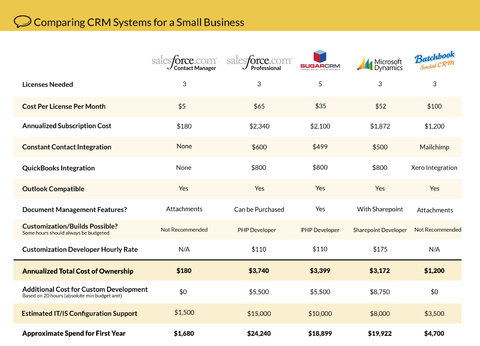Tech Support
What small-business owners need to know about technology.
 Courtesy of Empire Builders Group Amy Larrimore of the Empire Builders Group.
Courtesy of Empire Builders Group Amy Larrimore of the Empire Builders Group.
As discussed in the small-business guide we have just published, large businesses have long used customer relationship management software to automate sales and marketing and to manage their interactions with customers. In the last several years, though, small businesses have started using this kind of software, too. In part, that’s because the programs have become cheaper and easier to use.
Sorting through all of the options, however, can be a challenge. To discuss those options, we turned to Amy Larrimore, the managing partner of the Empire Builders Group in Philadelphia. Ms. Larrimore, who leads the firm’s information systems and technology division and who helps companies of all sizes choose the right technology for their needs, prepared the graphic below, which compares estimated costs for several customer relationship systems and is based on research Empire did for an actual client. The following conversation has been condensed and edited.
How does a customer relationship management system change things for a small business that traditionally knew many of its customers personally?
I think almost all businesses need some form of a C.R.M. Before technology solved this problem, business owners used to do it on index cards in a recipe box, because you need some way to track leads, prospects, clients and champions in order to grow a business. The problem is the human brain cannot store complex patterns above a very small quantity.
If you have 200 clients, 500 prospects and 1,000 leads (a very small database), and you interact with them in person, on the phone, on social media, on e-mail and hear about them from other people or read about them in the newspaper, that’s a lot to keep track of. How many of them have kids on their way to college — if you’re a financial adviser? How many of them are lawyers or have legal training? Who wants to remodel their house in the next year? These are not questions you can easily answer, so most of the time businesses find when they put what they know about disparate people into a database, they get some amazing insight into what or how to sell.
What are the biggest differences between the customer relationship management needs of small businesses and larger businesses?
The No. 1 thing is that a really small business is not going to need the same level of sophistication. They probably aren’t operating in 50 countries and needing translation support for all of them, for example. If you need your C.R.M. to show you screens in six major languages, you’re not going to get that with Batchbook. But for the majority of small businesses, their needs aren’t that sophisticated.
Due diligence is a second area of difference. Large businesses walk into a C.R.M. meeting with Salesforce, and they have with them a cost analysis, a capital expenditure analysis for the next three years. And they can ask really good questions to find out if this is the best thing for the money — whereas a small business doesn’t have the resources for that. There’s a big need for consumer education when it comes to C.R.M. for small businesses, and it’s not happening. So C.R.M. systems are being sold to small businesses who don’t understand what they are buying.
Another differentiator between large and small businesses: I.T. and infrastructure. Small businesses usually have no I.T. support so they pay for it as a service, whereas a larger company has an I.T. department headed by a chief information officer. If you’re Nike, you’re paying to run your C.R.M. system on your own private Amazon cloud. But if you’re a small business, where are you going to install and run your C.R.M. software? And the answer most often is, “I have no idea what this question means.” If that’s the case, there are 50 C.R.M. systems you shouldn’t be using. You need a turnkey, software-as-a-service model, the one where you give your credit card information and start using it.
How are these newer customer relationship management systems — Nimble, Capsule, Insightly and Close.io — different from the older one?
You can access these newer ones from the Web. Although we’ve been able to access these things from the Web for years, it’s less clunky and challenging now. The bandwidth for the average person’s home Internet service is better than what most companies could get five years ago.
I always recommend to clients who want to use Salesforce that they will need a dedicated person to manage it, a database administrator. But these smaller, newer C.R.M. systems don’t integrate in that old school way. Most of them, out of the box, will play happily with other applications small-business owners use, like Constant Contact or MailChimp. The biggest difference is that you can access these C.R.M. systems on the Web, on someone else’s server, from any device. They tend to have less required configurations and customizations and need less technical staff to manage them — they are, basically, more user-friendly.
You have said that small businesses don’t really have a good sense of the whole cost of their customer relationship management systems. Why is that?
You can’t just look at a company’s price per user listed on their Web site. Let’s say, for instance, you need to hire a developer to help you customize the C.R.M. Many times that’s needed if a feature is required but not available out of the box or if support is needed on the integration side. That means you need a developer, who is someone who can write code. That’s more than $100 an hour and a developer won’t even talk to you unless the job is at least 20 hours.
We created the chart (below), which compares estimated costs for several C.R.M. systems, so you can see what’s really involved. We added “configuration support” because you have to remember that while these systems are friendly out of the box, they aren’t turnkey. Want custom reports that give you what your trusty Excel sheet gives you? You have to build them? Want to track people’s pet’s names? You need your own field.
What do you typically recommend to small businesses looking for a customer relationship management system?
I like to compare it to someone car shopping. If someone were to come to me and say, “I’d like to buy a car. What do you think is a good car?” it’s an impossible question to answer well. After a few questions to identify what they really want to accomplish, the task becomes much easier.
Also, you need to know that it’s a magic bullet in the sense that it can show you who to sell to and what to sell to them. But you’re still going to have to make those phone calls, make those sales appointments and follow up with those contacts. I see too many businesses walking into a C.R.M. system expecting it to increase their sales. It’s not. It will help your sales representatives increase their sales.
Whenever I get asked the return on investment question around a C.R.M. system, I answer like this: If you had 30 percent more qualified leads a month, what would you do with them? How many of them would you close? What would that look like for your revenue? If you’re not ready to get serious around your sales process, it probably isn’t worth the money, no matter what the size of your business.
 This chart was prepared by a consulting firm, the Empire Builders Group, for one of its small-business clients. This client had three staff members who needed access to a C.R.M. system and wanted it to integrate with Microsoft Outlook and QuickBooks. It also wanted to continue to use Constant Contact and had more than 10,000 contacts to manage. This chart compares the costs of four different C.R.M. systems.
This chart was prepared by a consulting firm, the Empire Builders Group, for one of its small-business clients. This client had three staff members who needed access to a C.R.M. system and wanted it to integrate with Microsoft Outlook and QuickBooks. It also wanted to continue to use Constant Contact and had more than 10,000 contacts to manage. This chart compares the costs of four different C.R.M. systems.
You can follow Eilene Zimmerman on Twitter.
Article source: http://boss.blogs.nytimes.com/2013/04/03/do-small-businesses-understand-the-c-r-m-systems-they-are-buying/?partner=rss&emc=rss
Speak Your Mind
You must be logged in to post a comment.